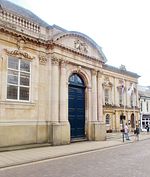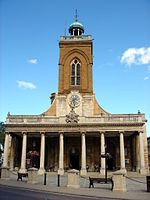Northampton Museum and Art Gallery

Northampton Museum and Art Gallery is a public museum in Northampton, England. The museum is owned and run by West Northamptonshire Council and houses one of the largest collection of shoes in the world, with over 15,000 pairs, which was designated by Arts Council England as being of local, national and international importance. The town's museum was established in 1865, but moved to the current site in 1884, where it shared its space with the town's library. After the library moved in 1910, the museum took over the whole building. The museum was extended in 1935 and again in 1988. In 2012, the museum was refurbished for better access.The museum closed between 2017 and 2021 for a major £6.7m expansion project. The new museum reopened in July 2021, more than a year later than planned due to the COVID-19 pandemic.
Excerpt from the Wikipedia article Northampton Museum and Art Gallery (License: CC BY-SA 3.0, Authors, Images).Northampton Museum and Art Gallery
Guildhall Road,
Geographical coordinates (GPS) Address External links Nearby Places Show on map
Geographical coordinates (GPS)
| Latitude | Longitude |
|---|---|
| N 52.2366 ° | E -0.8946 ° |
Address
Central Museum
Guildhall Road 4-6
NN1 1DP , Semilong
England, United Kingdom
Open on Google Maps











